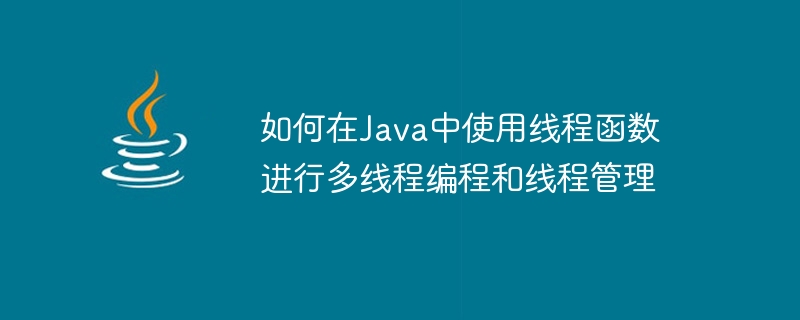

Multi-threaded programming is a common and important programming technology. In the Java language, using thread functions for multi-threaded programming and thread management is essential. This article will introduce in detail how to use thread functions in Java for multi-thread programming and thread management, and provide specific code examples.
1. Basics of multi-threaded programming
In Java, using thread functions for multi-threaded programming requires understanding the following basic concepts:
2. Use thread functions to create multi-threads
Java provides two ways to create threads: inheriting the Thread class and implementing the Runnable interface. The following describes how to use these two methods respectively.
public class MyThread extends Thread {
public void run() {
// 线程执行的代码
System.out.println("Thread running");
}
}
public class Main {
public static void main(String[] args) {
MyThread myThread = new MyThread();
myThread.start();
}
}In the way of inheriting the Thread class, you need to override the run() method of the Thread class and add it in Which writes the code that the thread executes. Then start the thread by creating the thread object and calling the start() method.
public class MyRunnable implements Runnable {
public void run() {
// 线程执行的代码
System.out.println("Thread running");
}
}
public class Main {
public static void main(String[] args) {
MyRunnable myRunnable = new MyRunnable();
Thread thread = new Thread(myRunnable);
thread.start();
}
}To implement the Runnable interface, you need to implement the run() method of the Runnable interface and write it in it The code executed by the thread. Then create a thread object by creating a Runnable object and passing it as a parameter to the constructor of the Thread class. Finally, call the start() method of the thread object to start the thread.
3. Thread management
Thread management includes thread priority setting, thread sleep and wake-up, thread waiting and notification and other operations.
Thread thread = new Thread(); thread.setPriority(Thread.MAX_PRIORITY); // 设置线程的优先级为最高
You can use the setPriority() method to set the priority of the thread. The priority range of the thread is 1 -10, where 1 is the lowest priority and 10 is the highest priority.
try {
Thread.sleep(1000); // 线程休眠1秒
} catch (InterruptedException e) {
e.printStackTrace();
}
// 唤醒线程
thread.notify();Use the Thread.sleep() method to make the thread sleep for a period of time. InterruptedException exceptions can be caught using try-catch blocks. Use the notify() method to wake up a waiting thread.
// 线程等待
synchronized (obj) {
try {
obj.wait(); // 线程等待
} catch (InterruptedException e) {
e.printStackTrace();
}
}
// 通知等待的线程继续执行
synchronized (obj) {
obj.notify();
}Use the wait() method to make the thread wait. You can use a synchronized block to acquire an object lock, wait with the wait() method, and wake up a waiting thread using the notify() method.
4. Summary
This article introduces how to use thread functions for multi-thread programming and thread management in Java, and provides specific code examples. By using thread functions, multiple tasks can be executed in parallel and the running efficiency of the program can be improved. At the same time, thread management and synchronization also need to be effectively processed to ensure the correct execution of threads.
Multi-threaded programming is a complex and important technology. In actual project development, thread synchronization and mutual exclusion need to be carefully handled to avoid problems such as data contention and deadlock. Through continuous learning and practice, master the basic concepts and skills of multi-thread programming, and be able to better use thread functions for multi-thread programming and thread management.
The above is the detailed content of How to use thread functions in Java for multi-thread programming and thread management. For more information, please follow other related articles on the PHP Chinese website!
 Zero-based Java self-study tutorial
Zero-based Java self-study tutorial
 What are the methods to implement operator overloading in Go language?
What are the methods to implement operator overloading in Go language?
 java string to number
java string to number
 What is the purpose of storage management?
What is the purpose of storage management?
 Mini program path acquisition
Mini program path acquisition
 How to register a Bitcoin wallet
How to register a Bitcoin wallet
 What are the methods to change password in MySQL?
What are the methods to change password in MySQL?
 USDT price today
USDT price today




